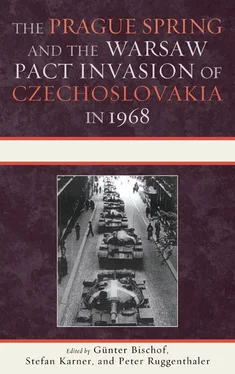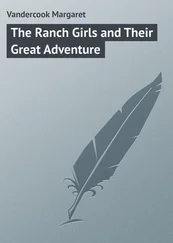33. Summary of meeting, 23 August 1968; see also minutes of secretary of defense staff meeting, 26 August 1968, Box 18, Clifford Papers, LBJL.
34. Memorandum of conversation (Rusk, Dobrynin, Thompson), 23 August 1968, Folder “23/8/68,” Box 1994, POL 27-1, CFPF, RG 59, NARA.
35. Minutes of the secretary of defense meeting, 26 August 1968, Box 18, Clifford Papers, LBJL. The Germans were pushing the strengthening of NATO above all else; see the memoranda of conversation between Chancellor Kiesinger and Henry Cabot Lodge, the U.S. ambassador in Bonn, 5 and 18 September 1968, in FRUS 1964–1968 , vol. 15, Germany and Berlin (Washington, DC: GPO, 1999), 733–37, 743–46, as well as summary of Lodge for the president, 28 September 1969, in FRUS 1964–1968 , vol. 15, Germany and Berlin , 750–51. The best discussion of the declining trajectory of the U.S. hegemonic position as result of the Vietnam War is George C. Herring, “Tet and the Crisis of Hegemony,” in Fink et al., 1968: The World Transformed , 31–53.
36. See also Mihail Ionescu, “Rumänien und die Invasion der ‘Bruderstaaten,’” in Karner et al., Beiträge , 605–16.
37. CIA memorandum, “Possible Soviet Threat to Rumania,” 23 August 1968, Folder “Cables 10/66–1/69,” Box 204, NSC Files, LBJL; Hillenbrand (Budapest) to Rusk, 28 August 1968, Folder 5, Box 2, CCF, RG 59, NARA.
38. George Kennan’s views on Czech intervention, Hilton memorandum, 29 August 1968, Folder 9, Box 179, NSC Country File, Czechoslovakia, LBJL.
39. Rusk Memorandum, “Expansion of Czechoslovakia Task Force to Include Romanian Contingency,” for president, 29 August 1968, Folder 9, Box 179, NSC Country File, Czechoslovakia, LBJL; NATO #04389, Cleveland to Rusk, 26 August 1968, Folder 5, Box 2, CCF, RG 59, NARA.
40. Memorandum of conversation (Rusk, Dobrynin, Thompson), 23 August 1968, FRUS, 256; Rusk to Cleveland (NATO mission), 31 August 1968; “Oral Communication from Ambassador Dobrynin of the USSR to Secretary Rusk,” 30 August 1968, both Folder “9/20/68,” Box 1997, POL 27-1, RG 59, NARA.
41. The “top secret” memorandum W. W. Rostow cabled to the president at the ranch in Texas on 30 August 1968 is more informative than the brief report Rusk sent to the NATO mission (see previous note), Folder 9, Box 179, NSC Country File, Czechoslovakia, LBJL.
42. “Remarks in San Antonio at the Annual Convention of Milk Producers,” 30 August 1968, Johnson, PPP, 1968, II, 917–20 (quotation 920); see also Kovrig, Of Walls and Bridges , 114; Dobrynin’s throwing water on the Washington rumor mills is mentioned in memorandum of conversation (Rusk and Norwegian ambassador Gunmeng), 11 November 1968, Folder 6, Box 3, CCF, RG 59, NARA.
43. See also the Jakovina chapter in this volume.
44. Thomas L. Hughes memorandum for Rusk, “Yugoslav Support of Czechoslovakia Persists Despite Scare over Soviet Aggression,” 28 August 1968, Folder “8/28/68,” Box 1995, POL 27-1, RG 59, NARA; Memorandum of conversation (Rusk, Ambassador Crnobrnja), 29 August 1968, Folder 6, Box 3, CCF, RG 59, NARA; for a summary of this conversation by Crnobrnja from the Serbian archives, see Karner et al., Dokumente , #147.
45. See also Peter Ruggenthaler, “Die Neutralität verplichtet: die sowjetisch-öster reichischen Beziehungen 1968,” in Karner et al., Beiträge , 993–1006.
46. Vienna #06326, MacArthur to Rusk (and Department of Defense), 30 August 1968, Folder “Vol. I 7/64 1/69,” Box 163, NSC Country File Austria, LBJL.
47. Brands, Wages of Globalism , 119.
48. “Austrian Contingency Arrangements: Information Memorandum,” Leddy to Rusk, 29 August 1968, Folder “9/20/68,” Box 1997, POL 27-1, RG 59, NARA.
49. Vienna #06276, MacArthur to Rusk, Folder 5, Box 2, CCF, RG 59, NARA; Austrian ambassador Wodak in Moscow was directed by the Ballhausplatz in Vienna to register a sharp protest in the Kremlin against these rumors, see Vienna #06275, MacArthur and Rusk, 29 August 1968, Folder 5, Box 2, CCF, RG 59, NARA; a similar protest by Bohlen is mentioned in Rusk to MacArthur, 28 August 1968, Folder “8/28/68,” Box 1995, CFPF, RG 59, NARA, reprinted in Karner et al., Dokumente , #180; the Moscow story of “green berets” in Austria also was included in the “Daily Situation Report” on 28 August of the Czech Task Force in the State Department; see Folder 5, Box 2, CCF, RG 59, NARA. About Austrian foreign minister Kurt Waldheim’s and Chancellor Josef Klaus’s protests with the Soviet ambassador in Vienna of 29 and 31 August, see Karner et al., Dokumente , #181 and #182; see also the Ruggenthaler chapter (note 45).
50. The only authors who cover de Gaulle’s curious “politics of history” in the Czech crisis are Kubricht, Confronting Liberalization and Military Intervention , 208–21, and Ouimet, Rise and Fall of the Brezhnev Doctrine , 32–34.
51. De Gaulle’s translated communiqué was quickly cabled back to the State Department on 21 August, see Folder “8/21/68,” Box 1993, POL 27-1, CPF, RG 59, NARA, reprinted in Karner et al., Dokumente , #198. See also Frédéric Bozo, Two Strategies for Europe: De Gaulle, the United States, and the Atlantic Alliance , trans. Susan Emanuel (Lanham, MD: Rowman & Littlefield, 2001), 223ff, and the Soutou chapter in this volume.
52. State #226360, Rusk to all diplomatic missions, 23 August 1968, Folder 4, Box 2, CCF, RG 59, NARA, reprinted in Karner et al., Dokumente , #204; the embassy in Vienna also presented this declaration to the Foreign Ministry. Ivan Pfaff has soundly rejected the myth of the “division of Europe” at Yalta and places the Soviet advances into Central Europe at the end of the war in the larger context of geostrategic developments; see “Die Legende von Jalta,” Forum für osteuropäische Zeitgeschichte 8, no. 2 (2004): 53–112.
53. Memorandum of conversation (Rusk, Luce, et al.), 26 August 1968, Folder 6, Box 3, CCF, RG 59, NARA.
54. Excerpts of Rusk speech before the Connecticut Manufacturers’ Association, 12 September 1968, Folder State Department [1 of 2], Box 64, NSC, Agency File, LBJL.
55. Paris #20083, Shriver to Rusk, 28 August 1968, Folder 5, Box 2, CCF, RG 59, NARA.
56. Vienna #06262, MacArthur to Rusk, 29 August 1968; Waldheim’s views in Vienna #06253, MacArthur to Rusk, 28 August 1968, both Folder 5, Box 2, CCF, RG 59, NARA.
57. Bonn #16394, Lodge to Rusk, 4 September 1968, Folder “9/1/68,” Box 1996, POL 27-1, CFPF, RG 59, NARA; this conversation is documented from the German side in Karner et al., Dokumente , #211; see also NSC Paper “The United States, Europe, and the Czechoslovakia Crisis” (n.d.), FRUS, 271.
58. Zedněk Mlynář, Nightfrost in Prague: The End of Humane Socialism , trans. Paul Wilson (New York: Karz, 1980), 241.
59. See Ouimet, Rise and Fall of the Brezhnev Doctrine , 33–34. This author set out on his archival visits with the goal on finding such a “smoking gun”; like Ouimet, he was unsuccessful.
60. In his final analysis for the Kremlin leaders of the Czech crisis, Dobrynin also came to the conclusion that the Czech Crisis strengthened NATO, see “Die USA propagieren die Stärkung der NATO,” 3 October 1968, reprinted in Karner et al., Dokumente , #217
61. For this larger context overshadowing the Czech crisis, see Schwartz, Johnson and Europe , 187–222; Schwartz, “Lyndon Johnson and Europe: Alliance Politics, Political Economy”; Schwartz, “‘Growing Out of the Cold War,’” in Brands, Johnson’s Foreign Policies , 37–60; Friedrich, “Awakenings”; Frank Costigliola, “Lyndon B. Johnson, Germany, and ‘the End of the Cold War,’” in Cohen and Bernkopf Tucker, Lyndon Johnson Confronts the World , 173–210; Bozo, Two Strategies for Europe , 187–218; Grosser, Das Bündnis , 293–358; Richard Barnett, The Alliance America-Europe-Japan: Makers of the Modern World (New York: Simon and Schuster, 1983); and various essays in Kaplan et al., NATO after Forty Years . The “dollar crisis” is keenly analyzed in Hubert Zimmermann, “Who Paid for America’s War? Vietnam and the International Monetary System, 1960–1975,” in Daum et al., America, the Vietnam War, and the World , 151–73. The enormous anxiety about Congressional pressure to reduce U.S. forces in Europe and thereby weaken the Western defense posture comes through strongly in the weekly staff meetings of the Department of Defense, see appendix 9 of this volume.
Читать дальше












